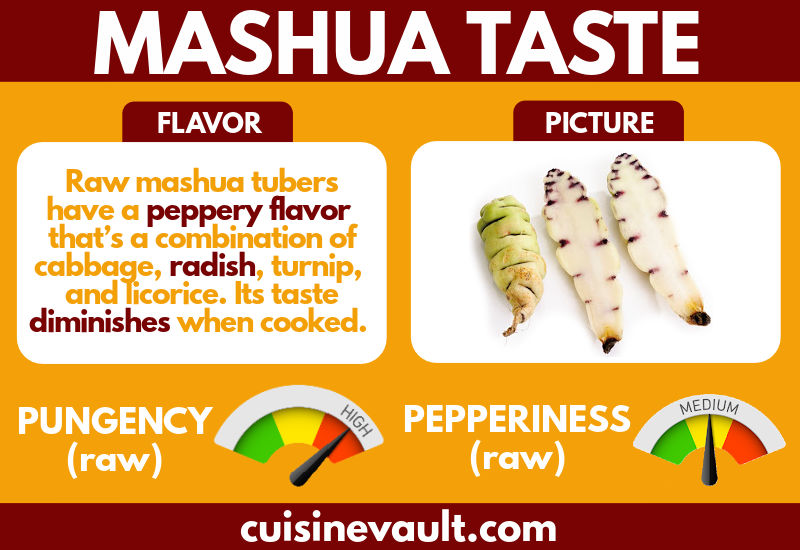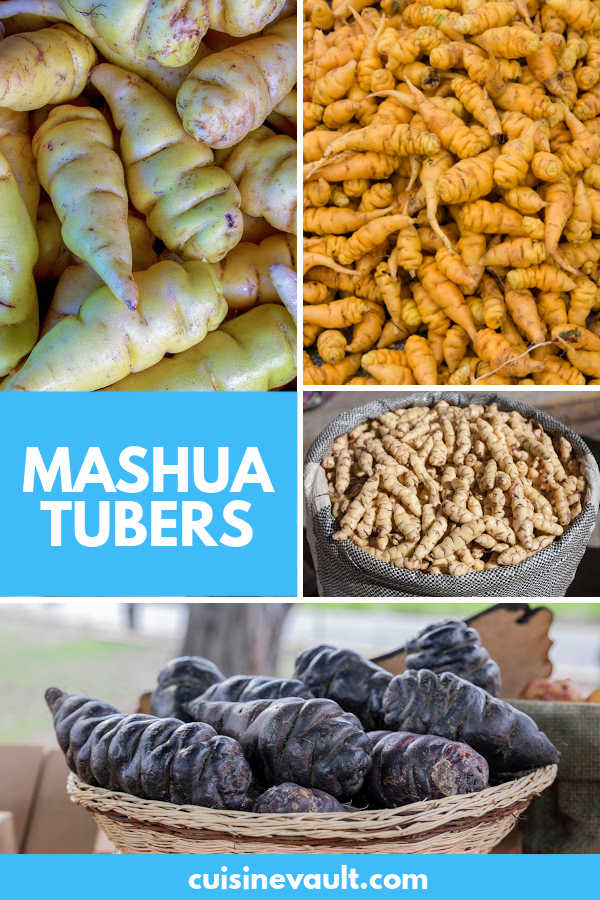The mashua is a cone-shaped tuber that has been used in South America for centuries as a source of food and medicine. The vegetable can range in size and color depending on the variety, but its flavor remains fairly consistent.
If you'd like to know what a mashua tastes like then keep reading to discover its taste, texture, and uses in the kitchen.
What do mashuas taste like?
Raw mashua tubers have a peppery flavor that are a pungent combination of cabbage, radish, turnip, and licorice. Although their flavor is a little sour and bitter when eaten raw, they become milder once cooked.
The raw mashua has dense and moist flesh that develops into a soft texture after cooking. Some compare the vegetable's consistency to mashed potato.
The mashua's flowers have an anise flavor and aroma, while the leaves are similar to mustard greens.
 Culinary uses
Culinary uses
Mashuas are a handy vegetable to have in the kitchen and can be used raw and cooked in dishes. Most people prefer their flavor once baked, fried, roasted, or boiled.
The vegetable pairs well with pungent spices like cumin and thyme and is excellent for adding balance to heavy, fatty meat dishes.
Some popular uses for mashuas in the kitchen include:
- Grate or finely slice over salads and coleslaws for a crunchy element with a spicy bite.
- Dice the tubers and add to soups, stews, and Indian curries.
- Use the leaves as a wrap, like you would banana leaves or sprinkle them into salads.
- For a cool, refreshing treat, freeze boiled mashuas and eat them like a healthy version of a popsicle.
- Drizzle the cooked tubers in honey and ricotta for another dessert option.
- Pickle mashuas to preserve them and eat in the off-season.
Pairs with: cumin, thyme, cilantro, black pepper, curry powder, poultry, beef, pork, squash, mushrooms, corn, sweet potato, beans, rice.
Substitutes: To replace mashuas in cooking, your best options are kohlrabi, sweet potatoes, or turnips.
Storage: The mashua has a waxy surface, but its higher moisture content than most other tuber varieties results in a shorter shelf life. To get the best out of your mashuas, store them in a cool location, out of direct sunlight, for 6-8 weeks.
How to cook mashuas
Serves: 4. Prep: 5 min. Cook: 15
Ingredients
- 8 mashuas
- 4 parsnips
- 1 Tbsp butter
- 1 tsp ground cilantro seeds
- ½ tsp ground cumin
- ½ tsp cinnamon
- ¼ tsp cracked pepper
- Salt to taste
- Squeeze of lemon
Method
- Cut off the ends of the mashuas and slice into halves lengthways.
- Peel and chop the parsnips into batonnets (sticks), then set the vegetables aside.
- Add butter to a pan on a medium-high heat and, once melted, sprinkle in the cilantro, cumin, and cinnamon. Toast until the aromatics fill the room.
- Reduce the heat to low and add the vegetables, cooking slowly until tender. Season with cracked pepper, salt, and lemon juice.
- Serve immediately with a knob of butter melted over the top.
Note:
You can peel mashuas if you prefer, but they’re thin and perfectly edible.
Nutritional Value
The mashua is a healthy ingredient to include in your diet and has various nutritional benefits including high levels of vitamin C, thiamin, riboflavin, niacin, protein, and glucosinolates. It is believed to assist with digestion, strengthen immunity, lower blood pressure, and improve skin health.
Interesting reading:
What is the best electric potato peeler?
Fast facts about mashuas
- The tuber is a flowering perennial with the botanical name Tropaeolum tuberosum; it is a member of the family Tropaeolaceae and is closely related to the common nasturtium flower.
- Other names include Papa Amarga, Añu, Cubio, and Isaño.
- The tubers range in size from 3-12” in length and have a conical shape. They grow on a climbing plant that reaches up to 13 feet in height.
- Mashua skin is thin, shiny, and waxy with many lumps. It can range in color - from white, yellow, and orange, through to purple and red.
- The plant is native to the Peruvian Andes, but thrives in any temperate climate, producing around 16 pounds of tubers.
- Mashua plants are often grown as ornamentals or next to other crops for their insect repelling abilities.
Summing up
The mashua is a tasty vegetable to include in your cooking. The locals from the Andean states of Peru have a long history of growing this edible root crop.
If you’re considering using it in a recipe, then keep in mind that this raw vegetable is peppery and pungent. Many people prefer it cooked as the texture softens and the flavor loses its bite.
We didn't mind the taste of mashuas, but they wouldn't be a top pick for a carb-loaded side dish. For a change from potatoes, we'd recommend the ube or taro as a great choice. Otherwise, try plantains if you prefer vegetables without any surprising flavors.


Leave a Reply